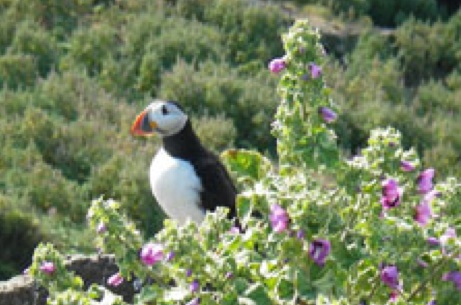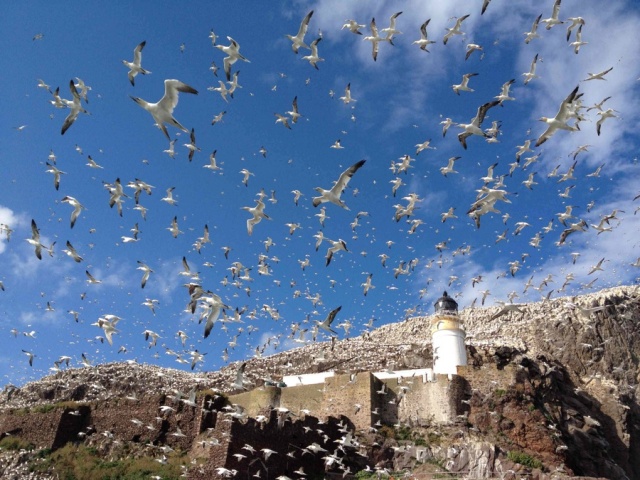Such a question would need little explaining, had you shared with me the trips we made out to the islands on Friday. I have been doing guiding on various boats for a number of summers now, this season for the Seabird Centre again. There are also trips available on the more traditional Sula II. It’s not full time, as I don’t want to take anyone else’s livelihood away so ask to be called in mainly as a relief. But, such is my enthusiasm that I am often embarrassed by tips and, since I don’t do it every day, every trip always gifts me something new to see and feels like I’m stealing a holiday.
Though not everyone’s cup of tea, I prefer crewing one of the RIBs than the more staid & stable Seafari Explorer. The RIBs will do 30 knots, although we didn’t get near that as the wind was strong out of the Southwest and spray would have drenched the passengers. We hadn’t even started the 1pm trip before skipper Brian was called to stand by the Seafari Explorer that was assisting a yacht in trouble.
Not long delayed because the Explorer’s powerful twin engines was more than capable of towing the small 20-footer (although bringing her alongside the South Pier would prove tricky in the gusty wind), our trip round Craigleith was rewarded by numbers of puffins bobbing in flotillas and lining the skyline like would-be extras from Zulu all along the sheltered North side.
Because of a bitter early Spring, puffins had arived late this year and so were a little behind schedule in leaving. The ‘puffin wreck’ of thousands of them all up the East Coast does not seem to have greatly affected numbers on Craigleith, which remain low at around 4,000 after losses due to Bass Mallow blocking their nesting burrows. Apart from a number of clumps at the western end (largely inhabited by gulls), this seems to have been mostly eradicated.
Numbers for other auks like guillemots and razorbills seemed healthy this year but now that nesting has ended for them, it’s hard to judge as they are all dispersed to sea. Despite plunging stats from elsewhere (including Dunbar Harbour) the dainty Kittiwakes appear to be prospering here as good numbers still inhabit the cliffs (as well as clinging on in odd corners among the gannets on Bass Rock). Even the local group of harbour seals seem healthy and are often spotted bobbing in the lee or hauled out at low tide.
It often strikes visitors who come out on the boats just how teeming with life Craigleith is. Even with the auks soon gone, there are cormorants and shags in their glossy plumage, the occasional fulmar and (though not this season) a peregrine. This also surprises them on passage down to Bass Rock, where the density of skeins of gannets flying low over the water builds as distance shortens until the passengers realise that the white on top isn’t guano but gannets—almost 150,000 of them.
Nearby, there is usually a whirling vortex of several hundred offshore as they practice their fishing technique (few surface fish survive this close to their rock) and even more hanging in a thick cloud above the cliff-top on the windward side, getting buffed and honing their gliding skills to perfection. As the cliffs continue underwater, it is easy to approach the Bass in a boat to within almost touching distance. But so close up you lose the sense of how many blanket the top.
The rock itself is fascinating; the phonolythic trachyte that was flowing in the neck of a Carboniferous volcano as it solidified. In the intervening quarter billion years that is all that’s left of the original mountain, with the rest of the cone eroded away. On the south side is the only spot not vertical from the water; it offers two places to land. So this is where both the Lauders castle was built in the 13th century and the NLB lighthouse in 1902. It is also the last place left of any space on the mile-circumference island that is not entirely thick with gannet nests.
Few first-time (& not many more several-time) visitors are not awestruck by the whole experience—so much wild nature so close to civilisation and accessible so easily from Scotland’s capital. For myself, I’ve clocked hundreds of such trips down the years and have yet to lose the excitement of it, because the weather, the tides, the sea state and especially the ever-changing inhabitants make each visit memorable for different reasons.
It has been so for hundreds of years. St Baldred used it as an inspiring retreat; James IV coveted it and, after a visit around 1500, Hector Boce, first Principal of Aberdeen University wrote:
“Ane wounderful crag, risand within the sea, with so narrow and strait hals that na schip nor boit bot allanerlie at ane part of it. This crag is callet the Bas; unwinnabil by ingine of man. In it are coves, als profitable for defence of men as [if] thay were biggit be crafty industry. Every thing that is in that crag is ful of admiration and wounder.”






Very interesting, and stunning photos too, which I would like to ‘save’ if ok with you. (will, of course, attribute to you) . AH
Annie: no problem—enjoy. D